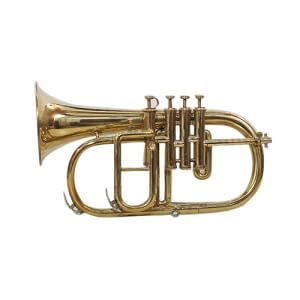Flugelhorn
 The flugelhorn is an end-blown lip-reed aerophone outfitted with valves (either piston, as seen in the gallery image, or rotary) that make it fully chromatic. Originating in continental Europe, the flugelhorn today can be found mostly there, strongly associated with military and marching bands. In the U.S.A.
The flugelhorn is an end-blown lip-reed aerophone outfitted with valves (either piston, as seen in the gallery image, or rotary) that make it fully chromatic. Originating in continental Europe, the flugelhorn today can be found mostly there, strongly associated with military and marching bands. In the U.S.A.
today it is encountered primarily in two domains: in jazz (listen to audio clip), where it is considered an auxiliary instrument on which trumpeters double; and in drum corps competitions. Though scored for in a few orchestral works it is not a standard member of that ensemble, and while the extensive classical solo repertoire of original pieces and transcribed works for the trumpet and cornet can be played on the flugelhorn it seldom is.
The flugelhorn is basically a 4.5-foot length of mostly conical brass tubing with a cup mouthpiece inserted at one end and a somewhat funnel-shaped bell at the other. This tubing passes through three spring-loaded piston valves that, when depressed individually or in combination, add varying lengths of tubing to the instrument’s basic length. Its three valves are located side-by-side at approximately the middle of the instrument. When a valve piston is unengaged (at the top of its casing) the air column passes directly through a channel bored into the piston; when the valve is engaged by pressing the piston down to the bottom of its casing two different channels come into alignment, one directing the air column out of the valve and through an additional length of tubing, and a second one allowing the air column back into and through the piston. The amount of tubing that is added is different with each valve: the first valve, closest to the mouthpiece end, adds enough tubing to lower the pitch of the instrument by a whole step (M2); the second valve by a half step (m2); and the third valve by a minor third (m3). Each additional length of tubing has its own tuning slide, and there is also a main tuning slide for general tuning in the instrument’s short lead pipe. Visually the flugelhorn can be distinguished from other soprano-register brass instruments with valves by its short, cylindrical, telescopic lead pipe, which functions as the instrument's tuning slide, that in a matter of a few inches enters the casing wall of the first valve; the much longer initial tube segment on trumpets and cornets typically includes one or more U-bends, one of which includes a tuning slide, before entering the third-valve casing wall. A deep cup mouthpiece is used for the instrument.